Forage Seed Market Research, 2031
The global forage seed market was valued at $22,808.2 million in 2021, and is expected to reach $44,186.1 million by 2031, registering a CAGR of 7.02% from 2022 to 2031.
In agriculture, the demand for nutritional needs has increased in farm animals and can be catered through natural forage. The nutritional quality of feed is influenced not only by the nutrient content, but also by other factors such as feed presentation, hygiene, digestibility, and effects on intestinal health. Thus, nutrient deficiencies in livestock can be resolved by providing them forage feed that maintain the rate of growth of livestock, their health, and well-being. People are becoming more conscious about their health and thus, the preference is given to organic food, as it does not contain pesticides.
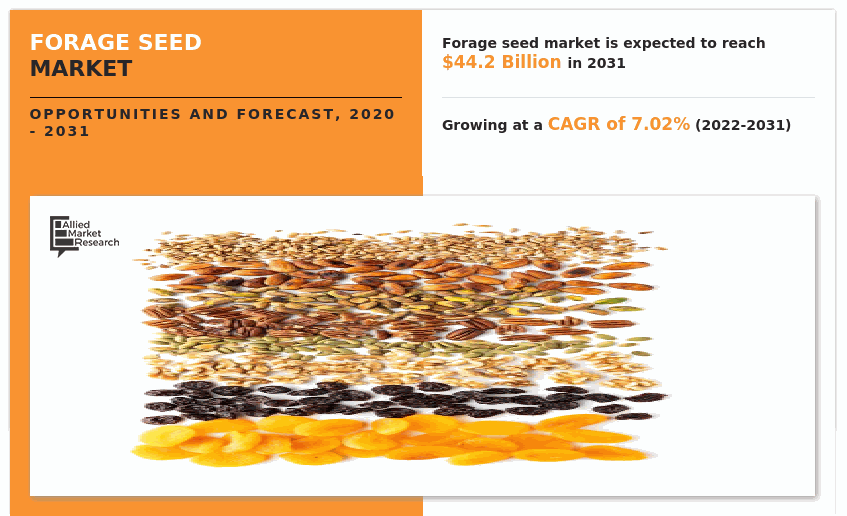
Market Dynamics
In agriculture, the demand for nutritional needs has increased in farm animals and can be catered through natural forage. The nutritional quality of feed is influenced not only by the nutrient content, but also by other factors such as feed presentation, hygiene, digestibility, and effects on intestinal health. Thus, nutrient deficiencies in livestock can be resolved by providing them forage feed that maintain the rate of growth of livestock, their health, and wellbeing. People are becoming more conscious about their health and thus, the preference is given to organic food, as it does not contain pesticides. Moreover, organic meat and milk are richer in nutrients and minerals such as enzymes, antioxidants, and bioflavonoid. Hence, people prefer organic food and organic meat over inorganic. This has led to increase in the organic feed demand to supply organic meat to consumers. Dairy farms, poultry sector, and animal husbandry have focused on purchasing high quality forage feed due to the growing demand for organic meat.
With the use of forage seeds, soil health can be improved and maintained as the producers not rely on synthetic fertilizer and pesticide inputs for forage seed farming. In forage seed production, cover crop forage mix is used that manage the health of soil. Cover crops primarily provide protection to soil, improve soil structure, increase organic matter, and capture and hold nutrients for forage crops. The demand for forage crop has increased due to need for improving soil health.
The major opportunity for the market in Asia Pacific lies in the region's growing livestock industry and the rising demand for sustainable animal feed solutions. Increasing meat and dairy consumption, driven by population growth and improving living standards, has led to higher demand for quality forage crops to support livestock health and productivity. Additionally, the shift towards organic and sustainable farming practices offers significant potential for forage seed adoption, as these crops help improve soil fertility and reduce dependency on chemical fertilizers. Governments in the region are also promoting initiatives to enhance agricultural productivity, further boosting the demand for high-yield, disease-resistant forage seeds. Countries like India, China, and Australia are particularly promising markets, given their large livestock populations and expanding dairy industries. Innovations in seed technology and tailored solutions for diverse climatic conditions in the Asia Pacific also provide avenues for forage seed market growth.
However, Natural calamities, such as droughts, floods, and frost create challenges in the production of forage feed. Forage seed requires more lead time (approximately 2-3 years to reap forage) to establish seed crop and harvesting. Thus, there is no instant return of investment. Natural disasters, climatic factors, and economic conditions can influence seed prices.
Segment Overview
The forage seed market is segmented into product type, livestock, species and region. Based on product, the market is segmented into clover, chicory, ryegrass, alfalfa, and others. Based on livestock, the market is segmented into cattle, swine, poultry, and others. Based on species, the market is segmented into legumes and grasses. Region wise, the market is analyzed across North America, Europe Asia-Pacific, and LAMEA.
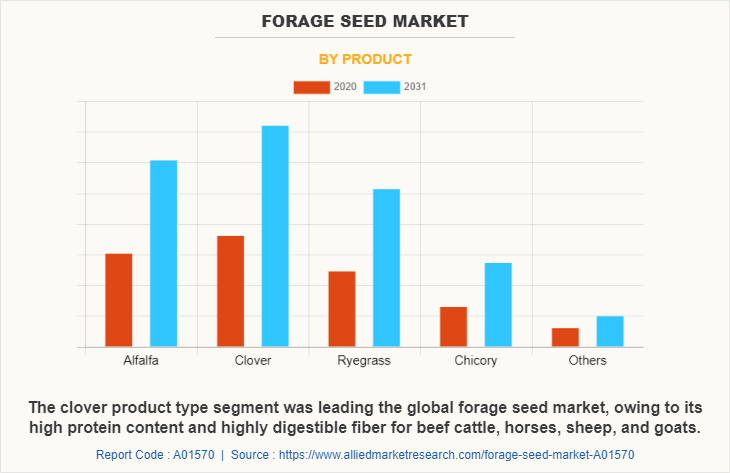
By Product Type
In 2021, the clover product type segment was leading the world forage seed market, owing to its high protein content and highly digestible fiber, and also for beef cattle, horses, sheep, and goats. Alfalfa product type is also another leading segment for market as it uses to improve soil quality and reduce the need for artificial fertilizers.
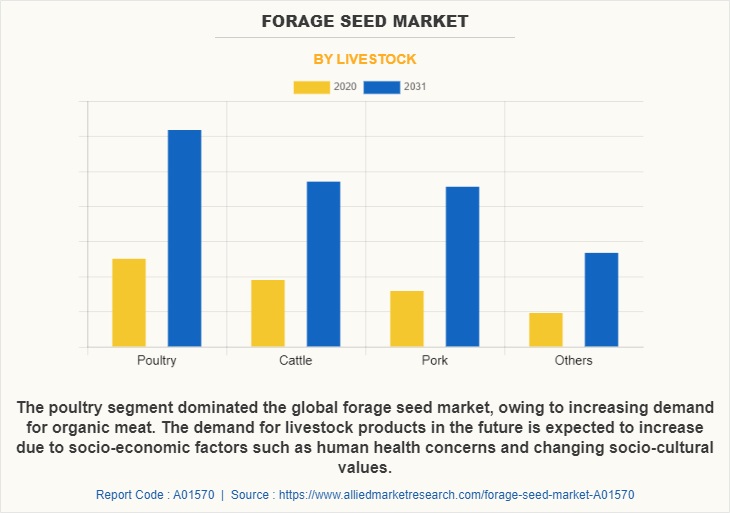
By Livestock
In 2021, the poultry segment dominated the global forage seed market share, owing to increasing demand for organic meat. The demand for livestock products in the future is expected to increase due to socio-economic factors such as human health concerns and changing socio-cultural values. In 2015, the poultry product dominated the market, owing to human population growth, income growth, and rapid urbanization.
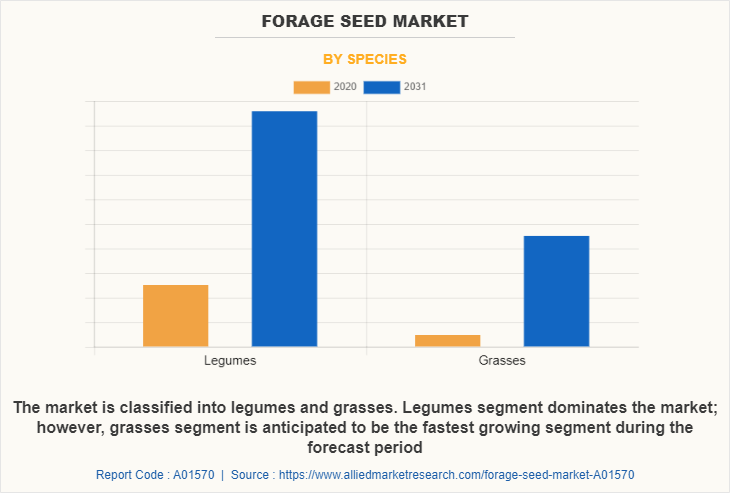
By Spices
By species, the market is classified into legumes and grasses. Legumes segment dominates the market; however, grasses segment is anticipated to be the fastest growing segment during the forage seed market forecast period (2022-2031).
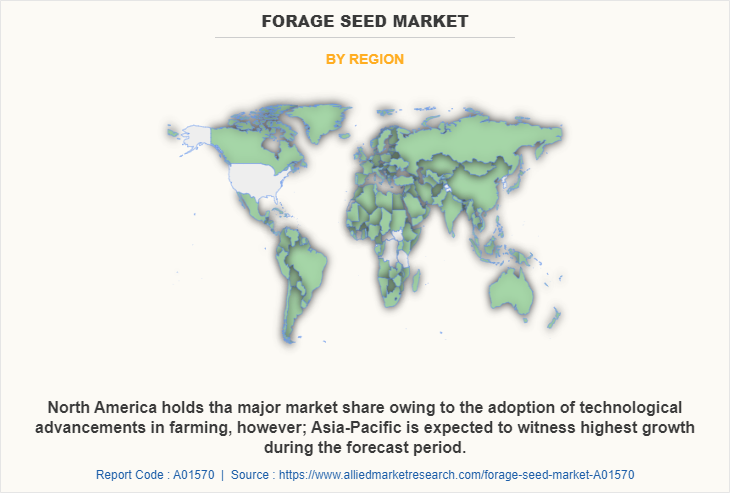
Competitive Analysis
Some of the major players operating in the global forage seed market analysis are Allied Seed, LLC., Brett Young, BASF SE, Dynamic Seeds Ltd., Central Garden & Pet Company, Barenbrug Seed Company, Northstar Seed Ltd., Hancock Farm & Seed Co. Inc., Foster’s Seed and Feed Ltd., and Dow AgroSciences, LLC. The other key market players (not profiled in this report) in the value chain include S&W Seed Company, Germinal GB, Heritage Seed Company, Advanta Seed International, Brett Young, DLF International Seeds, Barenburg Seeds, USA, Golden Acre Seeds, Moore seed Processors, Pickseed Canada Ltd, Wolf seeds Inc., Barenburg Seeds, Blue River Hybrids Organic Seeds, Ampac Seed Company, and Canterbury Seeds.
Key Benefits For Stakeholders
The report provides a quantitative analysis on forage seed market trends, estimations, and dynamics of the forage seed market size from 2020 to 2031 to identify the prevailing opportunities.
Porter’s five forces analysis highlights the potency of buyers and suppliers to enable stakeholders to make profit-oriented business decisions and strengthen their supplier–buyer network.
In-depth analysis, the market size, and segmentation assist to determine the prevailing forage seed market opportunities.
The major countries in each region are mapped according to their revenue contribution to the market.
The market player positioning analysis facilitates benchmarking and provides a clear understanding of the present position of the market players in the forage seed industry.
Forage Seed Market Report Highlights
| Aspects | Details |
| By Product |
|
| By Livestock |
|
| By Species |
|
| By Region |
|
| Key Market Players | Barenbrug Seed Company, Brett Young, Hancock Farm and Seed Co. Inc., Allied Seed, LLC., Central Garden and Pet Company, BASF SE, Northstar Seed Ltd., Fosters Seed and Feed Ltd., Dow AgroSciences, LLC, Dynamic Seeds Ltd. |
Analyst Review
According to the CXOs of the leading market players, North America has attained a leading position in this market because of the increasing health consciousness among people and rising demand for forage feed. This region provides lucrative opportunities for the growth to global forage seed producers, owing to its huge potential to set up infrastructure plants, growing demand for forage seed for organic meat, and increasing dairy demand among others. Rising demand for forage seed across the world, economic benefits with cultivating forage seeds such as improving soil health, and business flexibility are the major driving factors for the forage seed market.
Renowned global market leaders, such as Allied Seed LLC, Brett young, BASF SE, Dynamic Seeds Ltd., Central Garden & Pet Company, Northstar Seed Ltd., Foster’s Seed, and Feed Ltd. have adopted various growth strategies to expand their market presence and cater to the growing demand for forage seed in this region. Although North America has emerged as a lucrative region for investors, Europe and Asia-Pacific are perceived to be mature markets for the forage seed industry because of their high growth rate. Rising demand for organic meat to maintain a healthy lifestyle has created lucrative opportunities for the forage seed market.
The global forage seed market was valued at $22,808.2 million in 2021, and is expected to reach $44,186.1 million by 2031
The global Forage Seed market is projected to grow at a compound annual growth rate of 7.02% from 2022 to 2031 $44,186.1 million by 2031
Some of the major players operating in the global forage seed market analysis are Allied Seed, LLC., Brett Young, BASF SE, Dynamic Seeds Ltd., Central Garden & Pet Company, Barenbrug Seed Company, Northstar Seed Ltd., Hancock Farm & Seed Co. Inc., Foster’s Seed and Feed Ltd., and Dow AgroSciences, LLC. The other key market players (not profiled in this report) in the value chain include S&W Seed Company, Germinal GB, Heritage Seed Company, Advanta Seed International, Brett Young, DLF International Seeds, Barenburg Seeds, USA, Golden Acre Seeds, Moore seed Processors, Pickseed Canada Ltd, Wolf seeds Inc., Barenburg Seeds, Blue River Hybrids Organic Seeds, Ampac Seed Company, and Canterbury Seeds.
North America
Organic meat and milk are richer in nutrients and minerals such as enzymes, antioxidants, and bioflavonoid, which is why, people prefer them over inorganic alternatives. This in turn, is driving the growth of the global forage seed market.
Loading Table Of Content...



